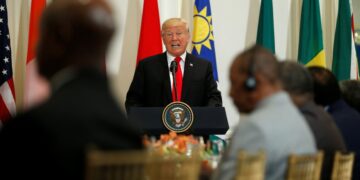5. Somalia
Somalia, officially the Federal Republic of Somalia[1] (Somali: Jamhuuriyadda Federaalka Soomaaliya, Arabic: جمهورية الصومال الفدرالية Jumhūrīyat aṣ-Ṣūmāl al-Fidirālīyah), is a country located in the Horn of Africa. It is bordered by Ethiopia to the west, Djibouti to the northwest, the Gulf of Aden to the north, the Indian Ocean to the east, and Kenya to the southwest. Somalia has the longest coastline on Africa’s mainland,[9] and its terrain consists mainly of plateaus, plains and highlands.[3] Climatically, hot conditions prevail year-round, with periodic monsoon winds and irregular rainfall.[10]
Somalia has an estimated population of around 12.3 million.[4] Around 85% of its residents are ethnic Somalis,[3] who have historically inhabited the northern part of the country. Ethnic minorities are largely concentrated in the southern regions.[11]The official languages of Somalia are Somali and Arabic, both of which belong to the Afroasiatic family.[3] Most people in the country are Muslim,[12] with the majority being Sunni.[13]
In antiquity, Somalia was an important commercial centre.[14][15] It is among the most probable locations of the fabled ancient Land of Punt.[16][17][18] During the Middle Ages, several powerful Somali empires dominated the regional trade, including the Ajuran Empire, the Adal Sultanate, the Warsangali Sultanate, and the Geledi Sultanate. In the late 19th century, through a succession of treaties with these kingdoms, the British and Italian empires gained control of parts of the coast and established the colonies of British Somaliland and Italian Somaliland.[19][20] In the interior, Mohammed Abdullah Hassan’s Dervish State repelled the British Empire four times and forced it to retreat to the coastal region,[21] before succumbing to defeat in 1920 by British airpower.[22] The toponym Somalia was coined by the Italian explorer Luigi Robecchi Bricchetti (1855–1926).[23] Italy acquired full control of the northeastern, central and southern parts of the area after successfully waging the so-called Campaign of the Sultanates against the ruling Majeerteen Sultanate and Sultanate of Hobyo.[20] Italian occupation lasted until 1941, yielding to British military administration. British Somaliland would remain a protectorate, while Italian Somaliland in 1949 became a United Nations Trusteeship under Italian administration, the Trust Territory of Somaliland. In 1960, the two regions united to form the independent Somali Republic under a civilian government.[24]





































Discussion about this post